It was a hot, humid, early July morning in 1981. I was 13 years old and spending the week with my grandparents on their farm in southern Maine, and had just returned from the stock pond with several large bull frogs. I was cleaning my game on the front lawn, which still was cool and damp with the morning dew, with my well worn, but razor sharp Boker pocket knife. A squadron of mosquito’s had set their sights on me earlier that morning at the pond as the sun rose, and had followed me back to the house, and appeared intent upon stopping my butchering job by attacking all exposed skin, specifically my sunburned areas. My blue jeans were soaked from my early morning hunt in the dew covered weeds and tall grass, and my t-shirt was wet from perspiration due to the humidity. I had also located some fresh duck eggs from waters edge, and brought those back as well. I had killed the frogs with my Bear 35 lbs recurve bow, and wood arrows tipped with both target points and blunts made from empty .32 S&W hulls. I had purchased the tackle the previous year at Woolworths, along with some spare cedar arrows, to compliment the original three that came from the Gainesville Florida factory along with the bow and armguard.
My grandfather, a lifelong gun hunter, who had come outside to see what I was doing and to enjoy the warm sunshine before the day became too hot, examined the long bright red bow, pulling the string back, feeling the taut power in its limbs. “So you shot all those frogs with this?” he asked. “How the hell did you learn to shoot arrows and to be able to hit anything?” I proudly explained how my mother had bought me a copy of “The Archer’s Bible” by Fred Bear, and I had followed Mr. Bear’s instructions on Instinctive shooting, picking a spot, and practicing, etc. And, I admitted, I wasn’t shooting farther than a few yards, as I stalked my prey as slowly as I could through the tall grass at the edge of the pond, in order to get as close as possible. Grandfather listened and ran his thick fingers over the smooth bow limbs. As we talked, I could smell the bacon and biscuits my Grandmother was cooking for breakfast, drifting out through the screen window of the kitchen. This was a special summer, the best of my teenage years and I realized it at that moment. I started to daydream, wishing that life could go on forever, just as it was, an endless summer at my Grandparent’s farm hunting and fishing without a care in the world. My Grandfather’s booming voice woke me from my fantasy; “Take your catch inside, and your Grandmother will fry them up for us in butter and we will have a breakfast fit for kings.” Then as he pulled the bow back to full draw, taking aim at the early morning sun, in his heavy Yankee accent he said “Ayuh… Fiberglass!”
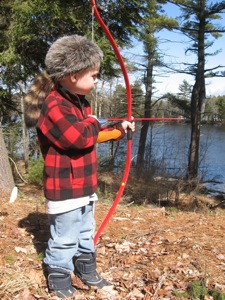 Countless traditional archers of years past have cut their teeth on solid fiberglass bows. During the 1950s, ’60s and ’70s, literally millions of rugged fiberglass longbows and recurves were mass produced by archery manufacturers like Ben Pearson, Bear Archery, Ply-Flex, Indian, Stream-Eze, Paul Bunyan, Outers, Parabow and many others. Sporting goods dealers, retail and hardware stores and catalogs offered colorfully boxed starter kits in various lengths and poundages comprised of a fiberglass bow, string, three or four arrows, a tab, armguard, target and instructions. Whether personally owned, borrowed from a friend, or as issued for the day at school or summer camp, these simple, rugged tools were the very foundation and introduction of several generations of North Americans to instinctive archery. I’m confidant that I’m far from alone in recalling a “golden summer” of my youth that included a fiberglass bow, be it a recurve or longbow. I can only imagine the vast number of birds, rabbits and squirrels and other wild (and some perhaps not so wild) creatures who have narrowly escaped being skewered by target arrows, launched from solid fiberglass bows over the past half century or so.
Countless traditional archers of years past have cut their teeth on solid fiberglass bows. During the 1950s, ’60s and ’70s, literally millions of rugged fiberglass longbows and recurves were mass produced by archery manufacturers like Ben Pearson, Bear Archery, Ply-Flex, Indian, Stream-Eze, Paul Bunyan, Outers, Parabow and many others. Sporting goods dealers, retail and hardware stores and catalogs offered colorfully boxed starter kits in various lengths and poundages comprised of a fiberglass bow, string, three or four arrows, a tab, armguard, target and instructions. Whether personally owned, borrowed from a friend, or as issued for the day at school or summer camp, these simple, rugged tools were the very foundation and introduction of several generations of North Americans to instinctive archery. I’m confidant that I’m far from alone in recalling a “golden summer” of my youth that included a fiberglass bow, be it a recurve or longbow. I can only imagine the vast number of birds, rabbits and squirrels and other wild (and some perhaps not so wild) creatures who have narrowly escaped being skewered by target arrows, launched from solid fiberglass bows over the past half century or so.
 Despite all the creatures that luckily averted their early demise at the hands of young archers armed with these low cost weapons, many were indeed not so fortunate. For many of us the fiberglass bow proved itself, in an almost magical and most memorable manner, of being a very capable and deadly hunting weapon. From the 1950s through the 1970s, there were many brands of fiberglass bows on the market, and quite a few were offered in heavier poundages than the standard 15-30 lbs target bows still being offered today. Some were advertised specifically for hunting, and not only for small and medium game, but for big game as well. These hunting bows could be purchased in the 35-80 lbs range.
Despite all the creatures that luckily averted their early demise at the hands of young archers armed with these low cost weapons, many were indeed not so fortunate. For many of us the fiberglass bow proved itself, in an almost magical and most memorable manner, of being a very capable and deadly hunting weapon. From the 1950s through the 1970s, there were many brands of fiberglass bows on the market, and quite a few were offered in heavier poundages than the standard 15-30 lbs target bows still being offered today. Some were advertised specifically for hunting, and not only for small and medium game, but for big game as well. These hunting bows could be purchased in the 35-80 lbs range.
I will be the first to admit that solid fiberglass bows pale in comparison to well built recurves and longbows consisting of wood (or bamboo), and fiberglass laminations, both in appearance and in performance. In my eyes, nothing is as sleek and attractive as a finely finished, laminated recurve with a maple core. The wood has depth and feeling, it comes “alive” in the hand, and begs to be taken outside and shot. Solid fiberglass bows do not have the speed or smoothness of wood core, laminated longbows and recurves, all things being equal. Even some well tillered and carefully crafted self bows have better cast and a smoother draw than the best solid fiberglass bows. Solid core fiberglass bows in the heavier weights are notorious for stacking as the string is drawn to anchor. Well made wood core recurves and longbows have little, if any stacking of weight, and are smoother to draw. Pride of ownership is as important to many as is appearance and performance. In this aspect, the classic wood bow, properly constructed and tuned, with or without fiberglass laminations, reigns supreme.
This being said, fiberglass bows have many strong points that are all too often overlooked. Aside from being the first archery tackle that many of us in the pre-compound and early compound era started out with, and are therefore familiar with, it has many advantages that offset its drawbacks.
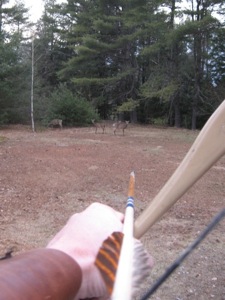 Price: the cost of a solid fiberglass bow has always been, and still is, relatively economical compared to fancier and better constructed equipment. For the beginner, or archer on a budget, the simple one piece, mass produced design is easy on the wallet. Kids and teens are notoriously rough on sporting equipment, and it makes sound financial sense to limit the initial investment until they prove their ability to properly use and care for equipment. A used 15 to 80 lbs solid fiberglass recurve can often be purchased at a yard sale or on E-bay for a fraction of the cost of a dozen new cedar arrows. A few years back at a gun show in Augusta, Maine, I purchased a vintage 1960s era Herter’s German made solid “Farbenglas” 65 lbs recurve with a leather wrapped longbow grip, and a handful of dusty feathered cedar hunting arrows for ten dollars, half of the original asking price. The old gun dealer was happy to be rid of it. I was thrilled to discover that one of the hunting arrows was a “Hill’s Hornet” broadhead! I have often wondered the history of this tackle since I bought it, who had owned it, the hunts it had been on, and the game it had shot, if any. Not pretty by any stretch of the imagination, the Herter’s Farbenglas is nonetheless a very well built and powerful bow, one of my favorites for stump shooting.
Price: the cost of a solid fiberglass bow has always been, and still is, relatively economical compared to fancier and better constructed equipment. For the beginner, or archer on a budget, the simple one piece, mass produced design is easy on the wallet. Kids and teens are notoriously rough on sporting equipment, and it makes sound financial sense to limit the initial investment until they prove their ability to properly use and care for equipment. A used 15 to 80 lbs solid fiberglass recurve can often be purchased at a yard sale or on E-bay for a fraction of the cost of a dozen new cedar arrows. A few years back at a gun show in Augusta, Maine, I purchased a vintage 1960s era Herter’s German made solid “Farbenglas” 65 lbs recurve with a leather wrapped longbow grip, and a handful of dusty feathered cedar hunting arrows for ten dollars, half of the original asking price. The old gun dealer was happy to be rid of it. I was thrilled to discover that one of the hunting arrows was a “Hill’s Hornet” broadhead! I have often wondered the history of this tackle since I bought it, who had owned it, the hunts it had been on, and the game it had shot, if any. Not pretty by any stretch of the imagination, the Herter’s Farbenglas is nonetheless a very well built and powerful bow, one of my favorites for stump shooting.
As most people today want to shoot compounds as they are easier to master, this has led to a flood of used traditional equipment in the second hand market, including solid glass longbows and recurves. If in good condition, and properly tuned–fitted with a new string and matched with properly spined arrows–many of the vintage and modern glass bows in lighter pull weights make superb and economical small game weapons. A 30-35 pound bow with judo tipped arrows is lethal medicine on snowshoe hares, (if you can connect!) and it won’t hurt your wallet too much to get set up properly with this gear either.
Durability: Fiberglass bows can be dragged through wet brush, used in the rain, left outside in the wet grass overnight, or you may poke the limb tip deep into a mud puddle and stir the water and silt if you will, (as children are prone to do) the bow is in no danger of delaminating, as they are impervious to moisture. Fiberglass bows have little danger of being over drawn, unlike wood self bows, which even with a rawhide or fiber backing can break if stressed even a few inches beyond the maximum draw length. Fiberglass bows can be left strung for long periods of time as well, say for example an extended hunting or camping trip, without fear of the limbs taking a set, as happens with wood that is not backed with fiberglass laminations. The molded one piece design is virtually indestructible, and perfect for bowfishing, hunting, canoe trips, etc. These are rugged weapons, plain and simple. If you want to purchase a more powerful model (over 30 lbs), you are pretty much limited to the used market, and while many gently used models in excellent condition are out there, be careful! Always check for cracks and hairline splits in the glass, as well as twisted limbs before buying and especially before shooting. If you are looking for a back up bow for hunting, or a low cost spare to leave at camp or in the garden shed (for varmints) or just another bow to cast arrows around your yard, consider picking up one of the heavier poundage models of yesteryear. I have an old Grayling, Michigan made Bear 40-45 lbs Black Fox recurve that I picked up on E-bay for $15.00. Nicked and scratched, this old war horse with its “semi-static” limbs will still cast an arrow tipped with a Zwickey Delta broadhead with enough zing and accuracy at 20 yards or so to easily kill a coyote, or deer.
Effectiveness: Once again, let me be clear that fiberglass bows are not as effective at casting arrows as are quality built laminated recurves and longbows, or the self bows built by craftsmen of today. In fact, most are probably not as effective as the ancient English yew longbows, Turkish recurves or the Japanese Bozai bows (or other Asiatic composites) that were, and still are, state of the art, handcrafted weapons built by craftsmen in those emerging cultures centuries ago. Solid fiberglass archery equipment was, and still is, mass produced with the primary focus on volume sales and profit.
That being said, however cheaply constructed, fiberglass bows DO work, and some of them work quite well. Countless small game, varmints and birds, and big game, have fallen to an arrow fired from a solid glass bow. The pages of archery magazines from the 1950s like “The National Bowhunter” and “Archery” contain numerous photos and articles detailing hunters who shot deer and other game with fiberglass bows. Even during the infancy of legal bow and arrow hunting, the focus then was as it should be now; shot placement and razor sharp broadheads. Despite many states setting the legal minimum poundage at 30 lbs for big game hunting bows, by 1957 archery tackle of at least 40-45 lbs pull was encouraged for deer hunting by many writers and experts, as well as The American Bowhunter’s Association, as it was common practice for novice hunters to use cheap bows made of lemonwood, hickory and solid fiberglass, which don’t have the efficiency of laminated tackle, all things (poundage, arrow weight, etc.) being equal. While many of these hunters did in fact take deer (and even elk!) with lightweight tackle in the 30 lbs range, far too many ended up only wounding and never recovering game, hence the emphasis on using heavier poundages in order to act ethically, get adequate killing efficiency and to preserve the sport for future generations.
If you can get past the stacking of the glass bows in heavier weights, (50 lbs +) most will throw a heavy arrow with a sharp broadhead with enough cast to penetrate through both sides of a whitetail deer at close range. If you chose to use a fiberglass bow for hunting deer, I would suggest that you figure on the “+10 lbs” rule; what ever bow weight you would chose in a modern laminated bow to hunt with, preferably as heavy as possible, add at least ten pounds when using a solid fiberglass bow. One wants as much cast and penetration as possible when hunting game with a glass bow, just as with a self bow made from wood.
Many of the Native Americans in North America hunted deer and other big game (and engaged in warfare) with simple flint pointed arrows fired from self bows of Hickory, Osage and Ash that had draw weights far less than what we would consider effective today. People throughout history have survived using primitive archery tackle, weak by modern standards, for the hunting of game both big and small. They learned to compensate for their weapons limitations by becoming better hunters and getting as close as possible. Compared to the crude bows that many indigenous tribes across the world used for their very survival by stalking and using ground blinds (and often poison tipped arrows), fiberglass bows are vastly superior weapons when it comes to range, accuracy and power.
I would be willing to bet that if we traveled back in time to the American northwest in the early 1800s with a supply of solid fiberglass bows of varying draw weights, they would very quickly become popular trade items with the Indian tribes, rivaling the musket and rifle in desirability, as obtaining a steady source of blackpowder was an issue in that location at that point in time. Many preferred the bow and arrow for hunting as well as war, due to both reliability (flintlocks are notoriously fickle in damp weather) and the speed that follow up shots could be delivered, as compared to the slow loading of single shot muzzle loaders.
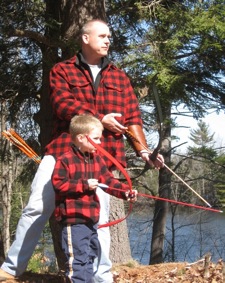 Dismiss my affection for “self bows” made of fiberglass, as nostalgia, and the bows themselves as children’s toys and mere junk, if you will. However the fact remains that these bows are as much a part of the history and culture of archery during the last century, as are Howard Hill’s bamboo longbows and Fred Bear’s Kodiak recurves. If it wasn’t for the solid fiberglass bow, millions of people wouldn’t ever have known the feeling of standing under a blue sky in the warm summer sun, and watching an arrow arch in its mystical path toward the target. Given the importance and overall usefulness of this basic but deadly introductory weapon to our sport, as far as I’m concerned I’ll agree with my Grandfather; “Ayuh…Fiberglass!”
Dismiss my affection for “self bows” made of fiberglass, as nostalgia, and the bows themselves as children’s toys and mere junk, if you will. However the fact remains that these bows are as much a part of the history and culture of archery during the last century, as are Howard Hill’s bamboo longbows and Fred Bear’s Kodiak recurves. If it wasn’t for the solid fiberglass bow, millions of people wouldn’t ever have known the feeling of standing under a blue sky in the warm summer sun, and watching an arrow arch in its mystical path toward the target. Given the importance and overall usefulness of this basic but deadly introductory weapon to our sport, as far as I’m concerned I’ll agree with my Grandfather; “Ayuh…Fiberglass!”



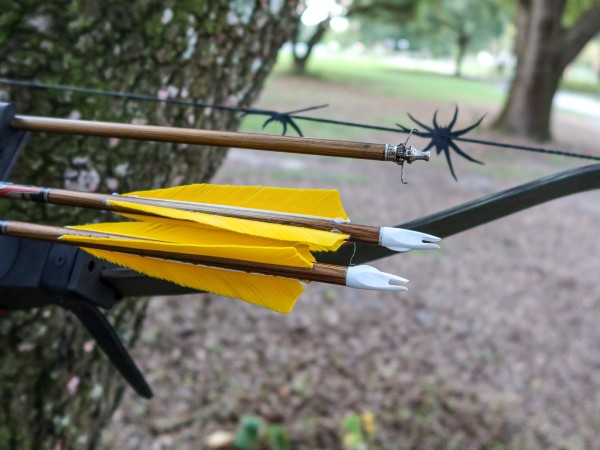


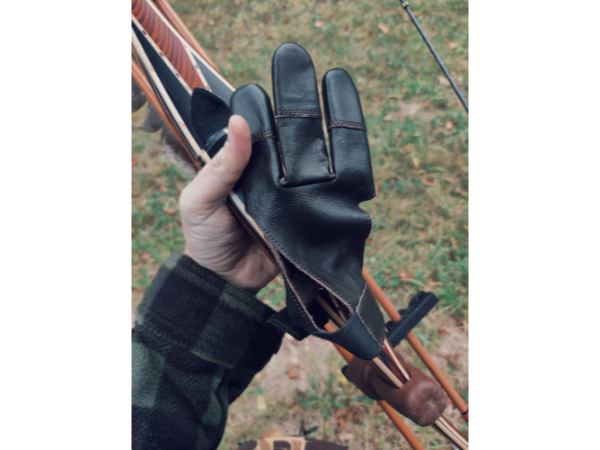
Thanks for the trip down memory lane Chris! As a youngster in 1959-60, my mom was afraid of a bow so I bought wooden arrows at the local hardware/auto supply store and threw them when I knew she could see what I was doing. Loved to watch them arc and still do. Made several attempts at a selfbow from our yew hedge and ultimately bought a 25# Ben Pearson solid glass recurve and arrows in ’62. Wandered Pennsylvania cornfields, swamps and forests with friends shooting at imaginary bears, moose, lions and tigers…glorified ‘stump shooting’…and also at blackbirds swaying on corn stalks. Whacked a ton of corn but never a bird! When arrows broke we mounted empty .30-30 cases and kept on shooting.
Bought a glass bow for my girlfriend(now wife of almost 44 years) to shoot on one of our first dates. Bought 2 glass youth bows within the last 3 years and have taught 3 grandkids how to shoot. A 6 yr old granddaughter requested her own as a birthday present last Fall; that makes 3 solid glass bows still in service, one from the 70’s! As long as I can still pull a bowstring, one will reside at our home for the next generation. Been teaching Hunter Education for 40 years and have used glass bows regularly. Thanks again!
I learned about fiberglass bows from a couple of YouTube videos. About a week or two ago, I was at my local Goodwill Thrift store and came across a Ben Pierson Junior Model #331. It did not have a string, but I paid only $10 and regardless of how much power it has, (Hunting/pest control might be out of the question) at least I have a bow I can shoot and develop skill with.
Great read……….Brought back great memories….Started with fiberglass 40 years ago..Still enjoy shooting them.Solid,durable and fun……
Ben Pearson 3330 jet bow
Ben Pearson #50
Stemmler #45
Shakespeare R8 #35
Thanks for the warm, sunny summertime memories..And here’s to the childhood discoveries of the simple things that direct our lives and hopefully continue to inspire younger generations
Fiberglass bows were used by Fred Bear and friends at one point and are MORE than capable of killing big games animals. A good friend of mine has take many 300 pound plus hogs with his Paul Bunyan fiberglass bow with a 45# draw weight. Native Americans would have been THRILLED to have a fiberglass bow, they are weather proof, don’t suffer from limb twist and are very accurate as well. Go out and buy one and see for yourselves everyone. The prices are going up and up on the good ones these days.
I can’t believe that I’m that little boy in the picture! Never read this till now! Awesome article dad